Understanding Motivation: Factors and Strategies for Workplace
VerifiedAdded on 2023/06/05
|9
|1852
|354
Report
AI Summary
This report explores the concept of motivation in the workplace, examining intrinsic and extrinsic factors that drive employee performance. It delves into Maslow's hierarchy of needs and analyzes various elements that motivate individuals, such as salary, workplace environment, and promotion opportunities. The report also identifies positive components that enhance employee experience, like organizational stability and learning opportunities, as well as negative factors like discrimination and ineffective management. Furthermore, it outlines strategies to cope with these negative factors, emphasizing fair treatment, appropriate training, and effective management practices. The conclusion highlights the importance of addressing both positive and negative influences to foster a motivated and productive workforce, with organizations needing to implement strategies that eliminate negative effects and increase positivity.
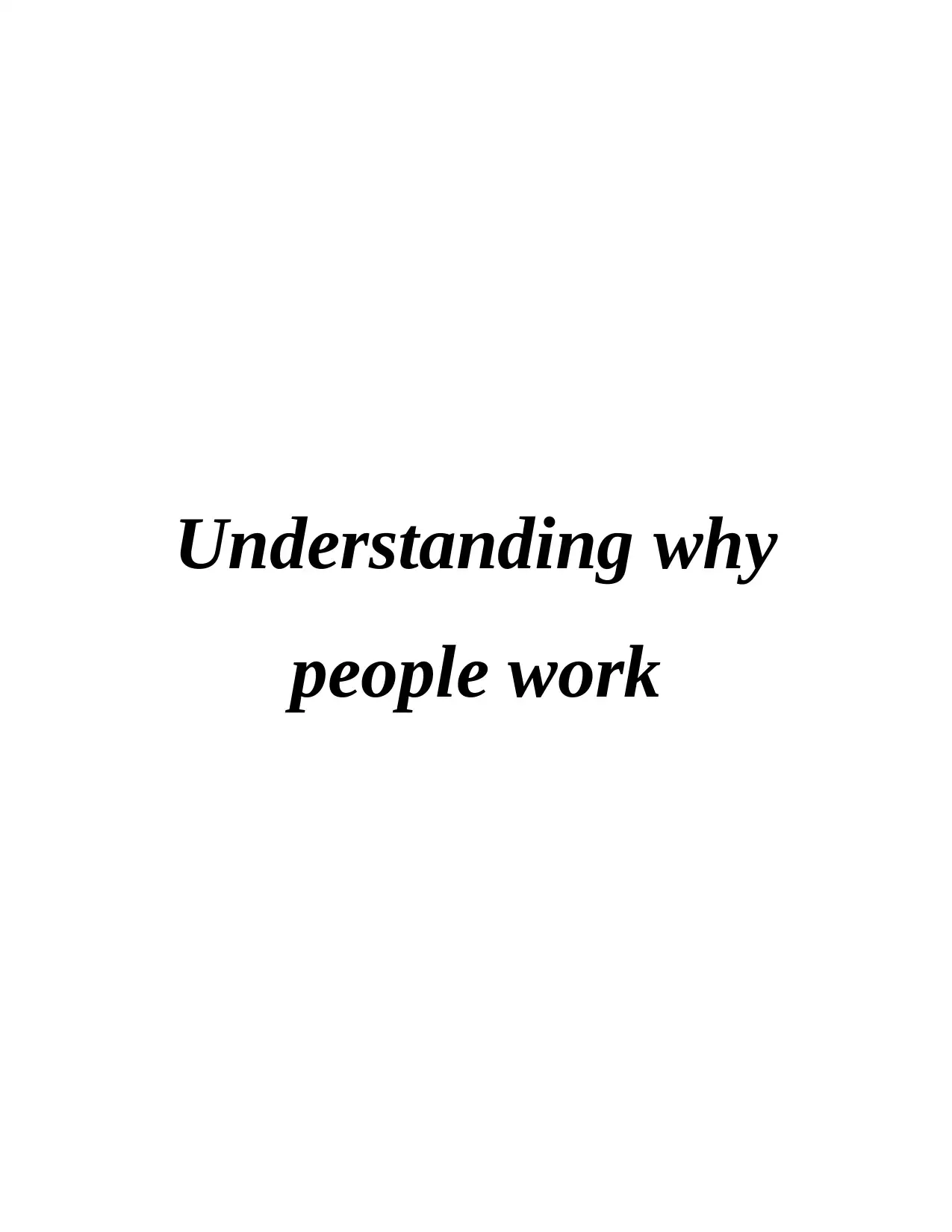
Understanding why
people work
people work
Paraphrase This Document
Need a fresh take? Get an instant paraphrase of this document with our AI Paraphraser
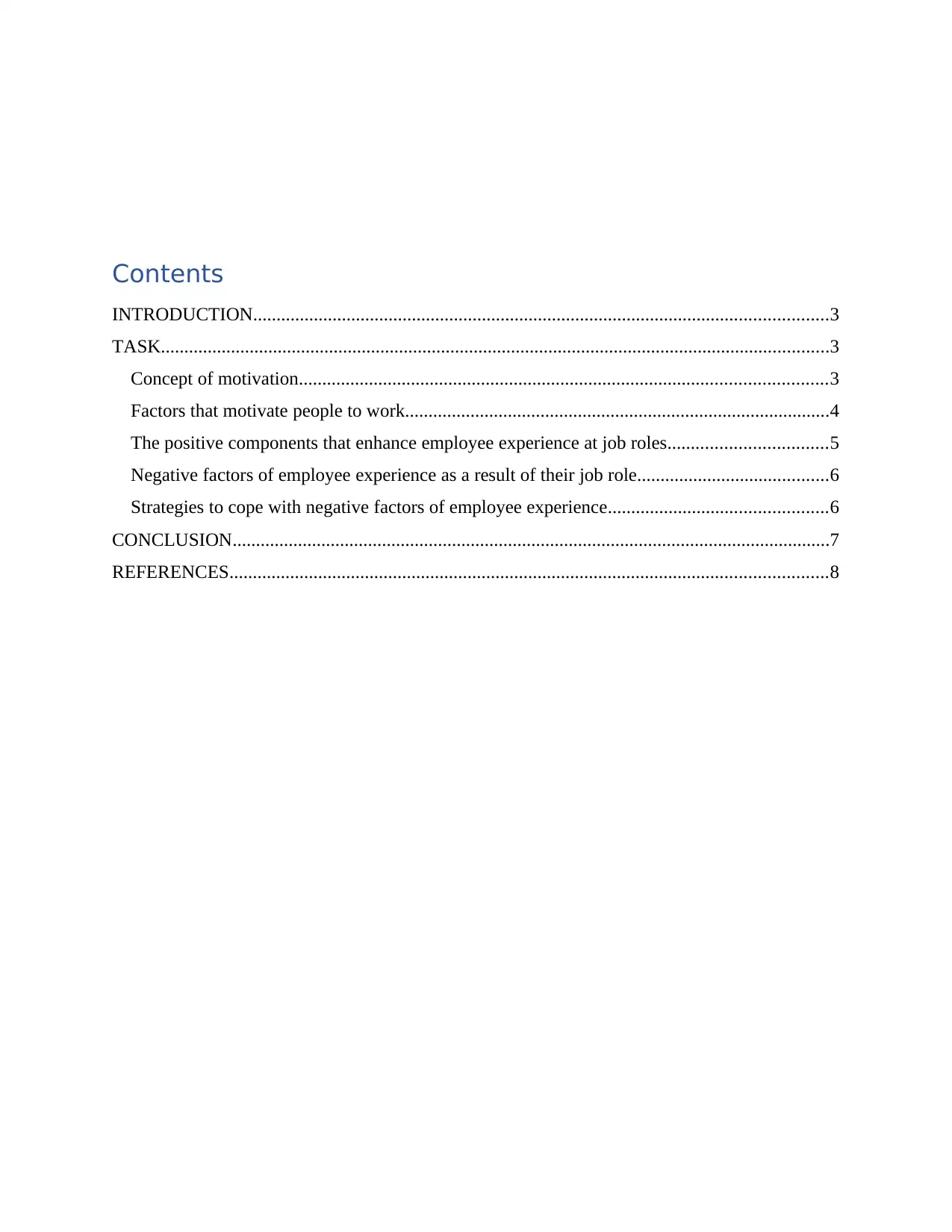
Contents
INTRODUCTION...........................................................................................................................3
TASK...............................................................................................................................................3
Concept of motivation.................................................................................................................3
Factors that motivate people to work...........................................................................................4
The positive components that enhance employee experience at job roles..................................5
Negative factors of employee experience as a result of their job role.........................................6
Strategies to cope with negative factors of employee experience...............................................6
CONCLUSION................................................................................................................................7
REFERENCES................................................................................................................................8
INTRODUCTION...........................................................................................................................3
TASK...............................................................................................................................................3
Concept of motivation.................................................................................................................3
Factors that motivate people to work...........................................................................................4
The positive components that enhance employee experience at job roles..................................5
Negative factors of employee experience as a result of their job role.........................................6
Strategies to cope with negative factors of employee experience...............................................6
CONCLUSION................................................................................................................................7
REFERENCES................................................................................................................................8
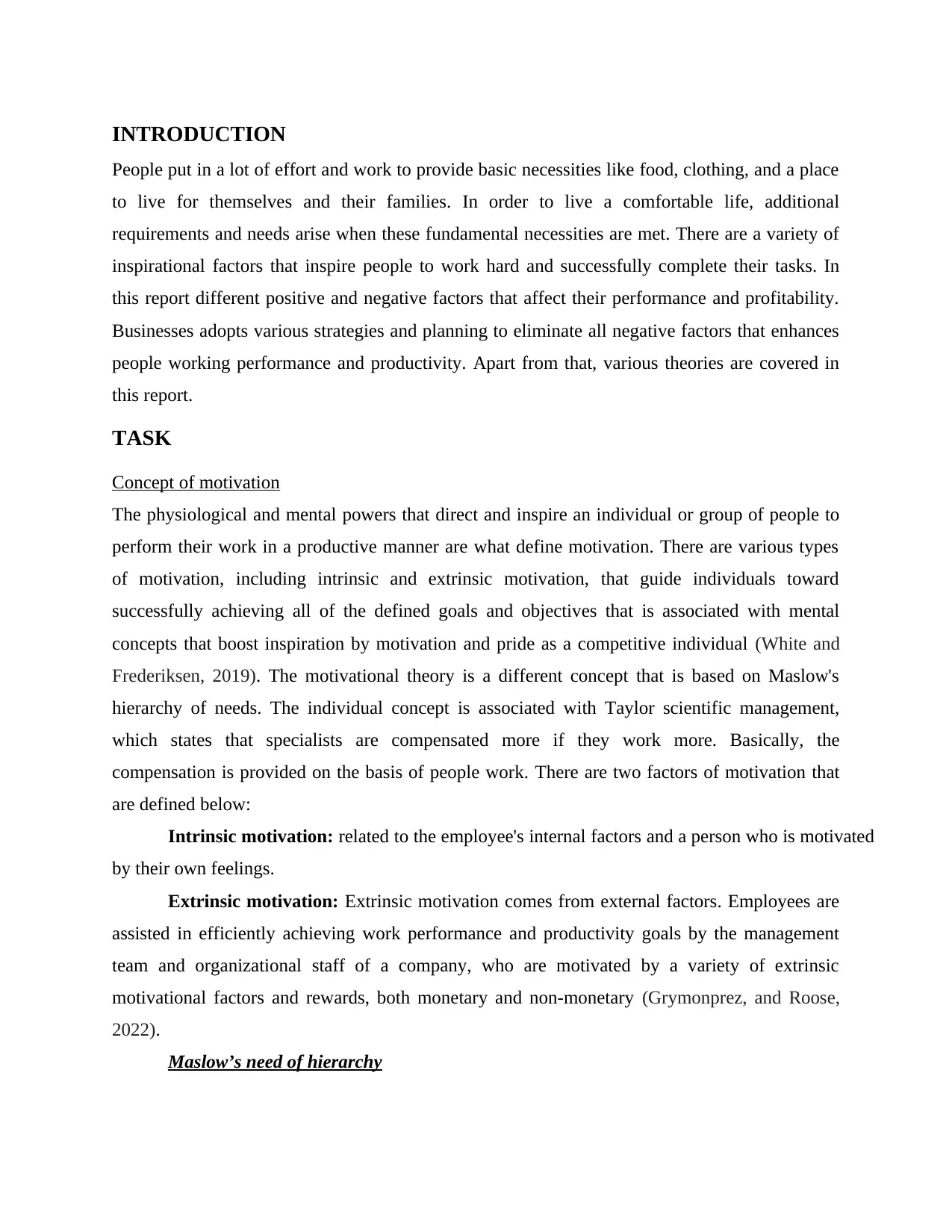
INTRODUCTION
People put in a lot of effort and work to provide basic necessities like food, clothing, and a place
to live for themselves and their families. In order to live a comfortable life, additional
requirements and needs arise when these fundamental necessities are met. There are a variety of
inspirational factors that inspire people to work hard and successfully complete their tasks. In
this report different positive and negative factors that affect their performance and profitability.
Businesses adopts various strategies and planning to eliminate all negative factors that enhances
people working performance and productivity. Apart from that, various theories are covered in
this report.
TASK
Concept of motivation
The physiological and mental powers that direct and inspire an individual or group of people to
perform their work in a productive manner are what define motivation. There are various types
of motivation, including intrinsic and extrinsic motivation, that guide individuals toward
successfully achieving all of the defined goals and objectives that is associated with mental
concepts that boost inspiration by motivation and pride as a competitive individual (White and
Frederiksen, 2019). The motivational theory is a different concept that is based on Maslow's
hierarchy of needs. The individual concept is associated with Taylor scientific management,
which states that specialists are compensated more if they work more. Basically, the
compensation is provided on the basis of people work. There are two factors of motivation that
are defined below:
Intrinsic motivation: related to the employee's internal factors and a person who is motivated
by their own feelings.
Extrinsic motivation: Extrinsic motivation comes from external factors. Employees are
assisted in efficiently achieving work performance and productivity goals by the management
team and organizational staff of a company, who are motivated by a variety of extrinsic
motivational factors and rewards, both monetary and non-monetary (Grymonprez, and Roose,
2022).
Maslow’s need of hierarchy
People put in a lot of effort and work to provide basic necessities like food, clothing, and a place
to live for themselves and their families. In order to live a comfortable life, additional
requirements and needs arise when these fundamental necessities are met. There are a variety of
inspirational factors that inspire people to work hard and successfully complete their tasks. In
this report different positive and negative factors that affect their performance and profitability.
Businesses adopts various strategies and planning to eliminate all negative factors that enhances
people working performance and productivity. Apart from that, various theories are covered in
this report.
TASK
Concept of motivation
The physiological and mental powers that direct and inspire an individual or group of people to
perform their work in a productive manner are what define motivation. There are various types
of motivation, including intrinsic and extrinsic motivation, that guide individuals toward
successfully achieving all of the defined goals and objectives that is associated with mental
concepts that boost inspiration by motivation and pride as a competitive individual (White and
Frederiksen, 2019). The motivational theory is a different concept that is based on Maslow's
hierarchy of needs. The individual concept is associated with Taylor scientific management,
which states that specialists are compensated more if they work more. Basically, the
compensation is provided on the basis of people work. There are two factors of motivation that
are defined below:
Intrinsic motivation: related to the employee's internal factors and a person who is motivated
by their own feelings.
Extrinsic motivation: Extrinsic motivation comes from external factors. Employees are
assisted in efficiently achieving work performance and productivity goals by the management
team and organizational staff of a company, who are motivated by a variety of extrinsic
motivational factors and rewards, both monetary and non-monetary (Grymonprez, and Roose,
2022).
Maslow’s need of hierarchy
⊘ This is a preview!⊘
Do you want full access?
Subscribe today to unlock all pages.

Trusted by 1+ million students worldwide
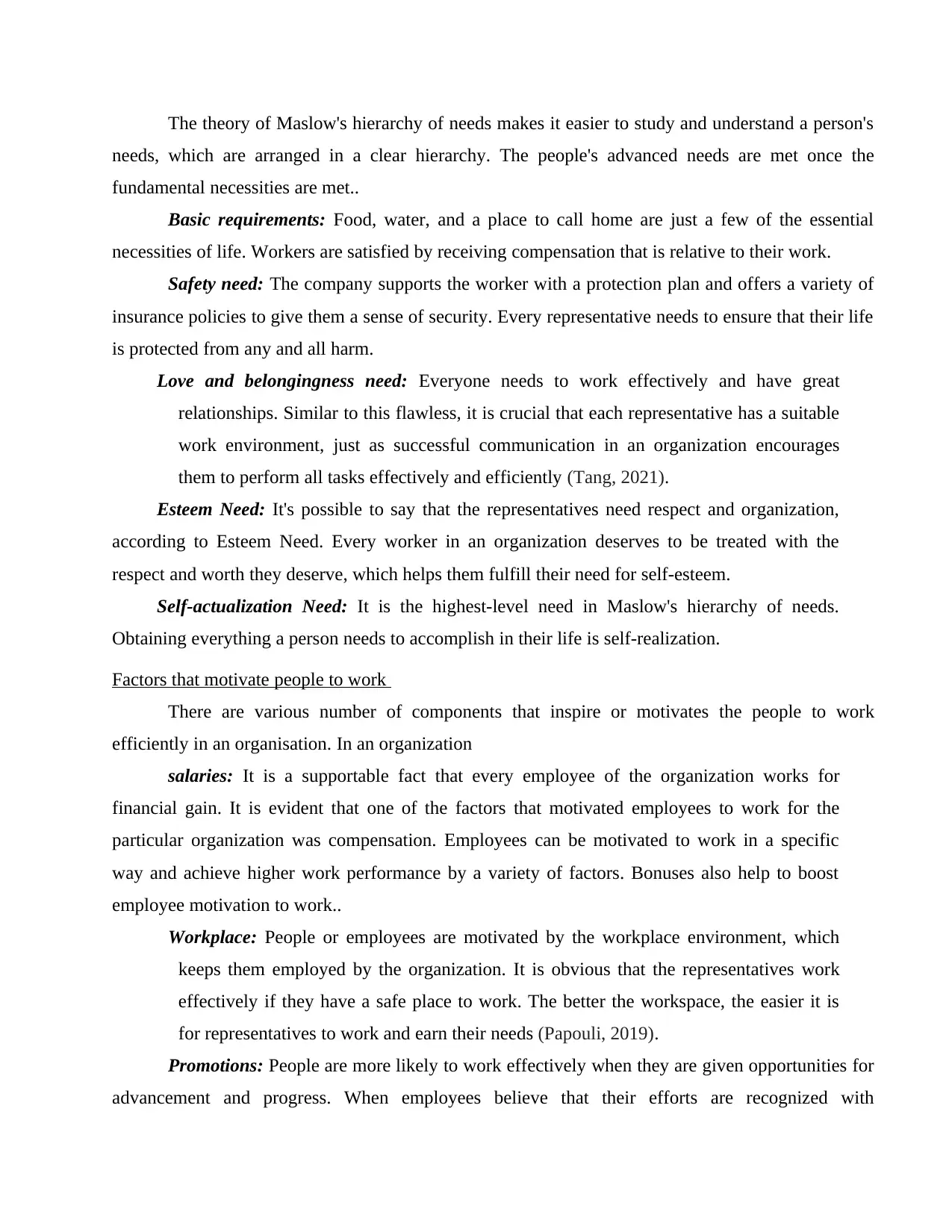
The theory of Maslow's hierarchy of needs makes it easier to study and understand a person's
needs, which are arranged in a clear hierarchy. The people's advanced needs are met once the
fundamental necessities are met..
Basic requirements: Food, water, and a place to call home are just a few of the essential
necessities of life. Workers are satisfied by receiving compensation that is relative to their work.
Safety need: The company supports the worker with a protection plan and offers a variety of
insurance policies to give them a sense of security. Every representative needs to ensure that their life
is protected from any and all harm.
Love and belongingness need: Everyone needs to work effectively and have great
relationships. Similar to this flawless, it is crucial that each representative has a suitable
work environment, just as successful communication in an organization encourages
them to perform all tasks effectively and efficiently (Tang, 2021).
Esteem Need: It's possible to say that the representatives need respect and organization,
according to Esteem Need. Every worker in an organization deserves to be treated with the
respect and worth they deserve, which helps them fulfill their need for self-esteem.
Self-actualization Need: It is the highest-level need in Maslow's hierarchy of needs.
Obtaining everything a person needs to accomplish in their life is self-realization.
Factors that motivate people to work
There are various number of components that inspire or motivates the people to work
efficiently in an organisation. In an organization
salaries: It is a supportable fact that every employee of the organization works for
financial gain. It is evident that one of the factors that motivated employees to work for the
particular organization was compensation. Employees can be motivated to work in a specific
way and achieve higher work performance by a variety of factors. Bonuses also help to boost
employee motivation to work..
Workplace: People or employees are motivated by the workplace environment, which
keeps them employed by the organization. It is obvious that the representatives work
effectively if they have a safe place to work. The better the workspace, the easier it is
for representatives to work and earn their needs (Papouli, 2019).
Promotions: People are more likely to work effectively when they are given opportunities for
advancement and progress. When employees believe that their efforts are recognized with
needs, which are arranged in a clear hierarchy. The people's advanced needs are met once the
fundamental necessities are met..
Basic requirements: Food, water, and a place to call home are just a few of the essential
necessities of life. Workers are satisfied by receiving compensation that is relative to their work.
Safety need: The company supports the worker with a protection plan and offers a variety of
insurance policies to give them a sense of security. Every representative needs to ensure that their life
is protected from any and all harm.
Love and belongingness need: Everyone needs to work effectively and have great
relationships. Similar to this flawless, it is crucial that each representative has a suitable
work environment, just as successful communication in an organization encourages
them to perform all tasks effectively and efficiently (Tang, 2021).
Esteem Need: It's possible to say that the representatives need respect and organization,
according to Esteem Need. Every worker in an organization deserves to be treated with the
respect and worth they deserve, which helps them fulfill their need for self-esteem.
Self-actualization Need: It is the highest-level need in Maslow's hierarchy of needs.
Obtaining everything a person needs to accomplish in their life is self-realization.
Factors that motivate people to work
There are various number of components that inspire or motivates the people to work
efficiently in an organisation. In an organization
salaries: It is a supportable fact that every employee of the organization works for
financial gain. It is evident that one of the factors that motivated employees to work for the
particular organization was compensation. Employees can be motivated to work in a specific
way and achieve higher work performance by a variety of factors. Bonuses also help to boost
employee motivation to work..
Workplace: People or employees are motivated by the workplace environment, which
keeps them employed by the organization. It is obvious that the representatives work
effectively if they have a safe place to work. The better the workspace, the easier it is
for representatives to work and earn their needs (Papouli, 2019).
Promotions: People are more likely to work effectively when they are given opportunities for
advancement and progress. When employees believe that their efforts are recognized with
Paraphrase This Document
Need a fresh take? Get an instant paraphrase of this document with our AI Paraphraser
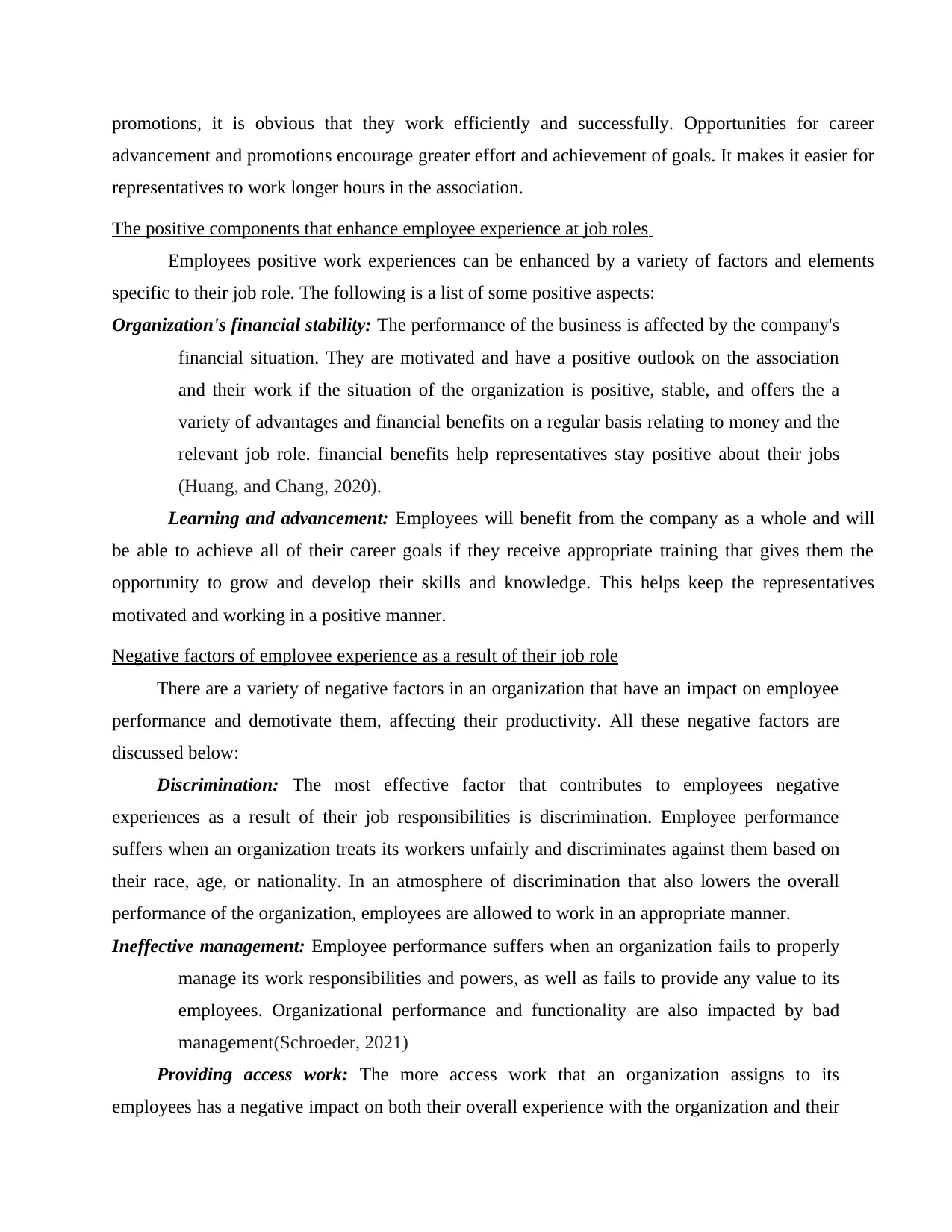
promotions, it is obvious that they work efficiently and successfully. Opportunities for career
advancement and promotions encourage greater effort and achievement of goals. It makes it easier for
representatives to work longer hours in the association.
The positive components that enhance employee experience at job roles
Employees positive work experiences can be enhanced by a variety of factors and elements
specific to their job role. The following is a list of some positive aspects:
Organization's financial stability: The performance of the business is affected by the company's
financial situation. They are motivated and have a positive outlook on the association
and their work if the situation of the organization is positive, stable, and offers the a
variety of advantages and financial benefits on a regular basis relating to money and the
relevant job role. financial benefits help representatives stay positive about their jobs
(Huang, and Chang, 2020).
Learning and advancement: Employees will benefit from the company as a whole and will
be able to achieve all of their career goals if they receive appropriate training that gives them the
opportunity to grow and develop their skills and knowledge. This helps keep the representatives
motivated and working in a positive manner.
Negative factors of employee experience as a result of their job role
There are a variety of negative factors in an organization that have an impact on employee
performance and demotivate them, affecting their productivity. All these negative factors are
discussed below:
Discrimination: The most effective factor that contributes to employees negative
experiences as a result of their job responsibilities is discrimination. Employee performance
suffers when an organization treats its workers unfairly and discriminates against them based on
their race, age, or nationality. In an atmosphere of discrimination that also lowers the overall
performance of the organization, employees are allowed to work in an appropriate manner.
Ineffective management: Employee performance suffers when an organization fails to properly
manage its work responsibilities and powers, as well as fails to provide any value to its
employees. Organizational performance and functionality are also impacted by bad
management(Schroeder, 2021)
Providing access work: The more access work that an organization assigns to its
employees has a negative impact on both their overall experience with the organization and their
advancement and promotions encourage greater effort and achievement of goals. It makes it easier for
representatives to work longer hours in the association.
The positive components that enhance employee experience at job roles
Employees positive work experiences can be enhanced by a variety of factors and elements
specific to their job role. The following is a list of some positive aspects:
Organization's financial stability: The performance of the business is affected by the company's
financial situation. They are motivated and have a positive outlook on the association
and their work if the situation of the organization is positive, stable, and offers the a
variety of advantages and financial benefits on a regular basis relating to money and the
relevant job role. financial benefits help representatives stay positive about their jobs
(Huang, and Chang, 2020).
Learning and advancement: Employees will benefit from the company as a whole and will
be able to achieve all of their career goals if they receive appropriate training that gives them the
opportunity to grow and develop their skills and knowledge. This helps keep the representatives
motivated and working in a positive manner.
Negative factors of employee experience as a result of their job role
There are a variety of negative factors in an organization that have an impact on employee
performance and demotivate them, affecting their productivity. All these negative factors are
discussed below:
Discrimination: The most effective factor that contributes to employees negative
experiences as a result of their job responsibilities is discrimination. Employee performance
suffers when an organization treats its workers unfairly and discriminates against them based on
their race, age, or nationality. In an atmosphere of discrimination that also lowers the overall
performance of the organization, employees are allowed to work in an appropriate manner.
Ineffective management: Employee performance suffers when an organization fails to properly
manage its work responsibilities and powers, as well as fails to provide any value to its
employees. Organizational performance and functionality are also impacted by bad
management(Schroeder, 2021)
Providing access work: The more access work that an organization assigns to its
employees has a negative impact on both their overall experience with the organization and their
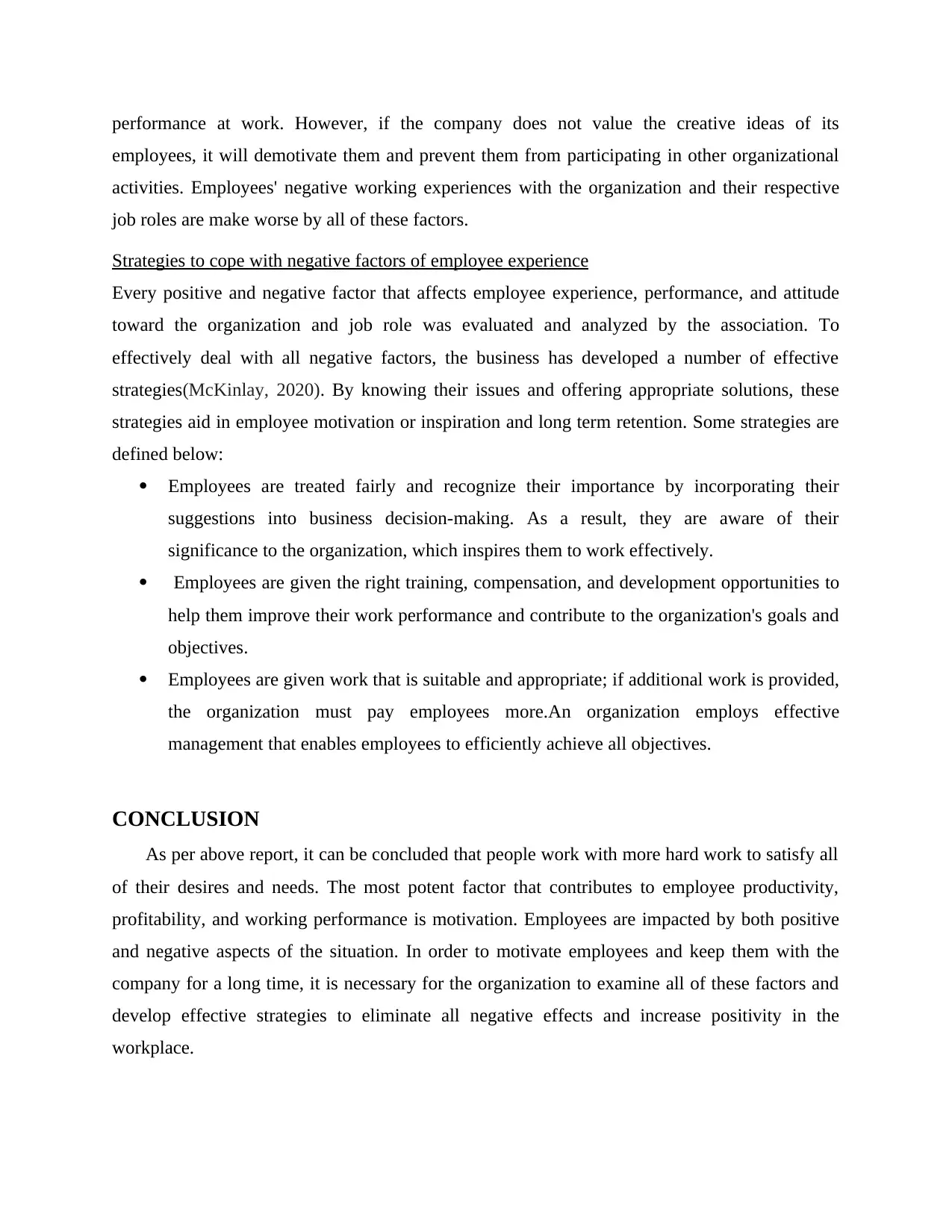
performance at work. However, if the company does not value the creative ideas of its
employees, it will demotivate them and prevent them from participating in other organizational
activities. Employees' negative working experiences with the organization and their respective
job roles are make worse by all of these factors.
Strategies to cope with negative factors of employee experience
Every positive and negative factor that affects employee experience, performance, and attitude
toward the organization and job role was evaluated and analyzed by the association. To
effectively deal with all negative factors, the business has developed a number of effective
strategies(McKinlay, 2020). By knowing their issues and offering appropriate solutions, these
strategies aid in employee motivation or inspiration and long term retention. Some strategies are
defined below:
Employees are treated fairly and recognize their importance by incorporating their
suggestions into business decision-making. As a result, they are aware of their
significance to the organization, which inspires them to work effectively.
Employees are given the right training, compensation, and development opportunities to
help them improve their work performance and contribute to the organization's goals and
objectives.
Employees are given work that is suitable and appropriate; if additional work is provided,
the organization must pay employees more.An organization employs effective
management that enables employees to efficiently achieve all objectives.
CONCLUSION
As per above report, it can be concluded that people work with more hard work to satisfy all
of their desires and needs. The most potent factor that contributes to employee productivity,
profitability, and working performance is motivation. Employees are impacted by both positive
and negative aspects of the situation. In order to motivate employees and keep them with the
company for a long time, it is necessary for the organization to examine all of these factors and
develop effective strategies to eliminate all negative effects and increase positivity in the
workplace.
employees, it will demotivate them and prevent them from participating in other organizational
activities. Employees' negative working experiences with the organization and their respective
job roles are make worse by all of these factors.
Strategies to cope with negative factors of employee experience
Every positive and negative factor that affects employee experience, performance, and attitude
toward the organization and job role was evaluated and analyzed by the association. To
effectively deal with all negative factors, the business has developed a number of effective
strategies(McKinlay, 2020). By knowing their issues and offering appropriate solutions, these
strategies aid in employee motivation or inspiration and long term retention. Some strategies are
defined below:
Employees are treated fairly and recognize their importance by incorporating their
suggestions into business decision-making. As a result, they are aware of their
significance to the organization, which inspires them to work effectively.
Employees are given the right training, compensation, and development opportunities to
help them improve their work performance and contribute to the organization's goals and
objectives.
Employees are given work that is suitable and appropriate; if additional work is provided,
the organization must pay employees more.An organization employs effective
management that enables employees to efficiently achieve all objectives.
CONCLUSION
As per above report, it can be concluded that people work with more hard work to satisfy all
of their desires and needs. The most potent factor that contributes to employee productivity,
profitability, and working performance is motivation. Employees are impacted by both positive
and negative aspects of the situation. In order to motivate employees and keep them with the
company for a long time, it is necessary for the organization to examine all of these factors and
develop effective strategies to eliminate all negative effects and increase positivity in the
workplace.
⊘ This is a preview!⊘
Do you want full access?
Subscribe today to unlock all pages.

Trusted by 1+ million students worldwide

Paraphrase This Document
Need a fresh take? Get an instant paraphrase of this document with our AI Paraphraser
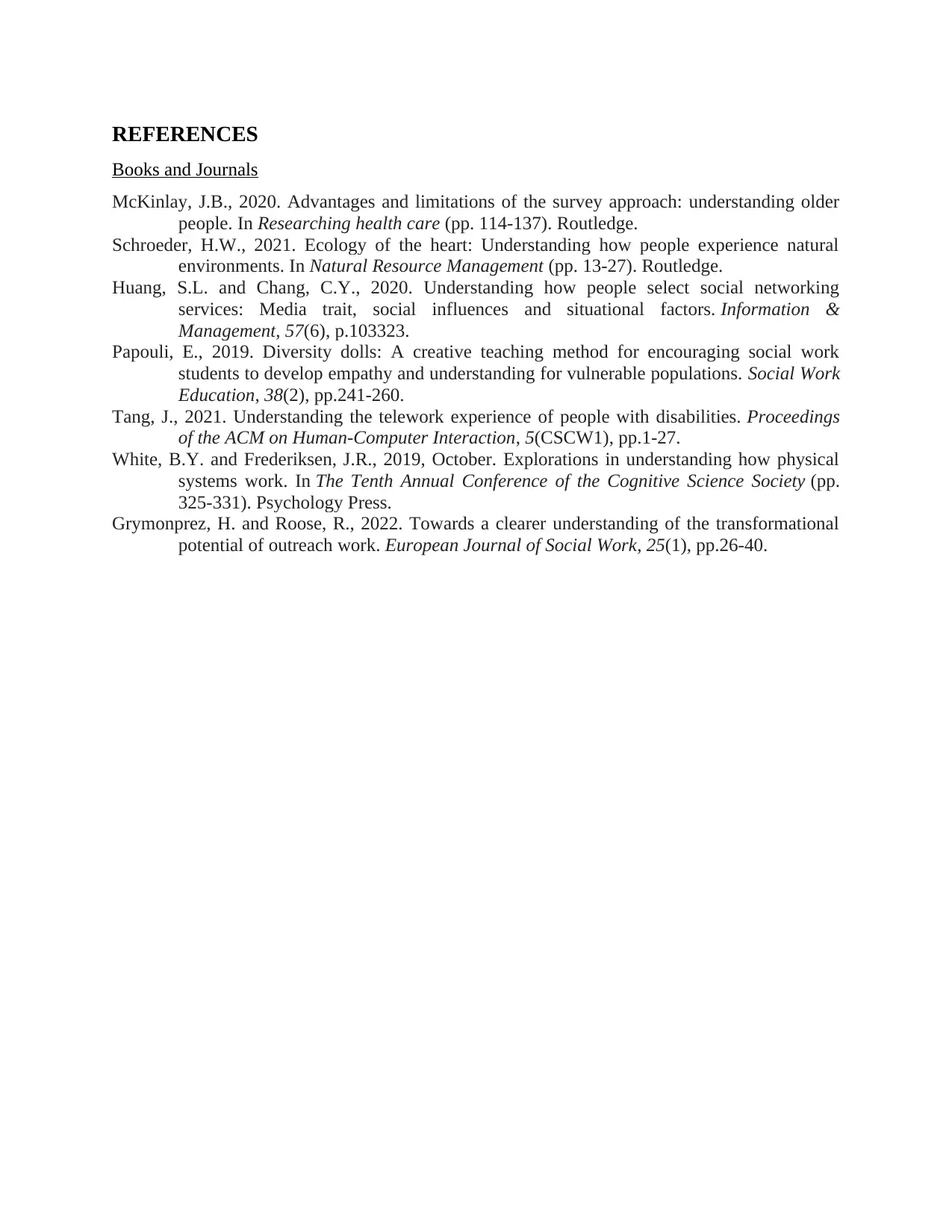
REFERENCES
Books and Journals
McKinlay, J.B., 2020. Advantages and limitations of the survey approach: understanding older
people. In Researching health care (pp. 114-137). Routledge.
Schroeder, H.W., 2021. Ecology of the heart: Understanding how people experience natural
environments. In Natural Resource Management (pp. 13-27). Routledge.
Huang, S.L. and Chang, C.Y., 2020. Understanding how people select social networking
services: Media trait, social influences and situational factors. Information &
Management, 57(6), p.103323.
Papouli, E., 2019. Diversity dolls: A creative teaching method for encouraging social work
students to develop empathy and understanding for vulnerable populations. Social Work
Education, 38(2), pp.241-260.
Tang, J., 2021. Understanding the telework experience of people with disabilities. Proceedings
of the ACM on Human-Computer Interaction, 5(CSCW1), pp.1-27.
White, B.Y. and Frederiksen, J.R., 2019, October. Explorations in understanding how physical
systems work. In The Tenth Annual Conference of the Cognitive Science Society (pp.
325-331). Psychology Press.
Grymonprez, H. and Roose, R., 2022. Towards a clearer understanding of the transformational
potential of outreach work. European Journal of Social Work, 25(1), pp.26-40.
Books and Journals
McKinlay, J.B., 2020. Advantages and limitations of the survey approach: understanding older
people. In Researching health care (pp. 114-137). Routledge.
Schroeder, H.W., 2021. Ecology of the heart: Understanding how people experience natural
environments. In Natural Resource Management (pp. 13-27). Routledge.
Huang, S.L. and Chang, C.Y., 2020. Understanding how people select social networking
services: Media trait, social influences and situational factors. Information &
Management, 57(6), p.103323.
Papouli, E., 2019. Diversity dolls: A creative teaching method for encouraging social work
students to develop empathy and understanding for vulnerable populations. Social Work
Education, 38(2), pp.241-260.
Tang, J., 2021. Understanding the telework experience of people with disabilities. Proceedings
of the ACM on Human-Computer Interaction, 5(CSCW1), pp.1-27.
White, B.Y. and Frederiksen, J.R., 2019, October. Explorations in understanding how physical
systems work. In The Tenth Annual Conference of the Cognitive Science Society (pp.
325-331). Psychology Press.
Grymonprez, H. and Roose, R., 2022. Towards a clearer understanding of the transformational
potential of outreach work. European Journal of Social Work, 25(1), pp.26-40.

⊘ This is a preview!⊘
Do you want full access?
Subscribe today to unlock all pages.

Trusted by 1+ million students worldwide
1 out of 9
Related Documents
Your All-in-One AI-Powered Toolkit for Academic Success.
+13062052269
info@desklib.com
Available 24*7 on WhatsApp / Email
![[object Object]](/_next/static/media/star-bottom.7253800d.svg)
Unlock your academic potential
Copyright © 2020–2025 A2Z Services. All Rights Reserved. Developed and managed by ZUCOL.


